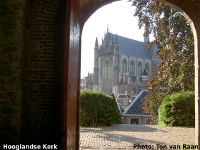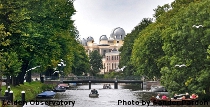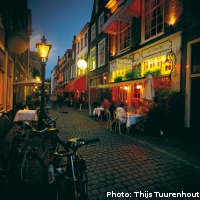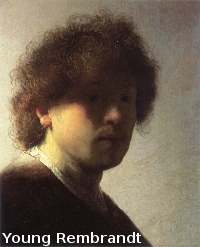Leiden - City of Discoveries, a city to discover
Leiden is a typical university city, hosting the oldest university in the Netherlands (1575). University buildings are scattered throughout the city and 40,000 students (University and University College) give the city a relaxed and vivid atmosphere.
Bustling, friendly and an international allure
 Leiden is a bustling, friendly medium-sized city, an urban community full of life with an outward-looking, international character, particularly with its famous university, more than 435 years old. Leiden and its suburbs have a population of 355,000, making it one of the major urban regions in the Netherlands.
Leiden is a bustling, friendly medium-sized city, an urban community full of life with an outward-looking, international character, particularly with its famous university, more than 435 years old. Leiden and its suburbs have a population of 355,000, making it one of the major urban regions in the Netherlands.
Leiden is an attractive city with a beautiful, large historic centre. Leiden’s charms are enhanced by the amazing range of temptations to be found in the surrounding region. The city is very close to the North Sea coast and to beautiful national parks in the dune landscape. Its suburbs to the west are attractive seaside resorts with international style. To the north and east, the city borders on several lakes, with ample sailing facilities. All of these are within easy cycling distance of Leiden.
Leiden University is one of Europe’s top universities, it boasts sixteen Nobel Prize winners, it is a member of the League of European Research Universities and positioned highly in international academic rankings.
Location
 The city centre of Leiden is just twelve kilometres east of the North Sea coast, and is located close to Amsterdam, The Hague, Rotterdam and Utrecht. Working and living in Leiden also means ease of mobility based on a well-developed infrastructure: Leiden has excellent connections by rail, air and road. It is just 15 minutes by direct intercity train to Schiphol, Amsterdam’s International Airport. Other intercity trains connect Leiden directly with Amsterdam (35 min.), The Hague (15 min.), Rotterdam (30 min.) and Utrecht (35 min.), giving Leiden a fast connection to the European rail network, including the high speed trains to Brussels, Paris and London.
The city centre of Leiden is just twelve kilometres east of the North Sea coast, and is located close to Amsterdam, The Hague, Rotterdam and Utrecht. Working and living in Leiden also means ease of mobility based on a well-developed infrastructure: Leiden has excellent connections by rail, air and road. It is just 15 minutes by direct intercity train to Schiphol, Amsterdam’s International Airport. Other intercity trains connect Leiden directly with Amsterdam (35 min.), The Hague (15 min.), Rotterdam (30 min.) and Utrecht (35 min.), giving Leiden a fast connection to the European rail network, including the high speed trains to Brussels, Paris and London.
Similar convenient connections are available for transport by car. Leiden is just a few minutes from the A4, one of the Netherlands most important motorways, and the A44.
History
 The history of Leiden dates back to Roman times. In around 50 A.D. the Romans built a fortress called Matilo in what is now the Roomburg city district. This was one of the ‘castella’ along the Old Rhine, built to protect the northern border of the Roman Empire. Matilo existed until about the year 275.
The history of Leiden dates back to Roman times. In around 50 A.D. the Romans built a fortress called Matilo in what is now the Roomburg city district. This was one of the ‘castella’ along the Old Rhine, built to protect the northern border of the Roman Empire. Matilo existed until about the year 275.
Since the 16th century, significant archaeological finds have been made, including Roman artefacts, many of which are on display in the National Museum of Antiquities located in the city centre.
Leiden started its development in around 860 as an embankment (‘dike’) settlement at the foot of a castle located strategically at the confluence of the Old Rhine and the New Rhine. In around 1100, Leiden became the court residence of the Counts of Holland.
Between the 13th and 15th centuries, the city prospered, developing into one of the largest cities in Holland by its flourishing textile industry. In the 16th century, the cultural role of Leiden increased in importance. Leiden became an international centre of painting art (Lucas van Leyden, Rembrandt, Van Goyen, van Steen).
With the establishment of the University in 1575, many eminent scientists were soon attracted to the city. Consequently, Leiden also became a centre of book printing and publishing (Elsevier, Plantijn). In order to escape from the Inquisition, Galileo Galilei published one of his most important works, the Discorsi, in Leiden (1637).
In the 17th century, the Dutch Golden Age, arts, science and industry developed further. Rembrandt was born in 1606 in Leiden. This was the period when first important scientific and technological discoveries took place. The city continued to grow and in around 1670 Leiden, with some 70,000 inhabitants, was the largest city in Holland after Amsterdam.
In the 18th century, the textile industry declined and Leiden rapidly became impoverished. At the end of the 19th and the beginning of the 20th century, the city recovered with the metal and printing industries. At the same time, Leiden University experienced the ‘Second Golden Age’, winning a series of Nobel prizes, particularly in physics and medicine.
Following a deterioration of the socio-economic position in the 1950’s and 60’s, Leiden again rapidly recovered. The city received major national funding to restore its historic city centre; new residential areas began to be built and the city witnessed the prosperous growth of the Bio Science Park as a result of the many application-oriented research activities generated by its University. Today, Leiden with its suburbs is a sought-after residential area with an agreeable socio-economic and cultural climate.
Cultural Heritage
 Leiden is a city with a rich cultural heritage, not only in science, but also in the arts. One of the world's most famous painters, Rembrandt, was born and educated in Leiden. Other famous Leiden painters include Lucas van Leyden, Jan van Goyen and Jan van Steen. The city has been one of Europe's most prominent scientific centres for more than four centuries. Modern scientific medical research and teaching started in the early 18th century in Leiden with Boerhaave. Many important scientific discoveries have been made here, giving rise to Leiden’s motto: ‘City of Discoveries’
Leiden is a city with a rich cultural heritage, not only in science, but also in the arts. One of the world's most famous painters, Rembrandt, was born and educated in Leiden. Other famous Leiden painters include Lucas van Leyden, Jan van Goyen and Jan van Steen. The city has been one of Europe's most prominent scientific centres for more than four centuries. Modern scientific medical research and teaching started in the early 18th century in Leiden with Boerhaave. Many important scientific discoveries have been made here, giving rise to Leiden’s motto: ‘City of Discoveries’
Leiden has retained all that its past has to offer: a picturesque, historic city centre in which the prosperity in past centuries is still visible in the noble 17th century mansions along the historic canals where many famous scholars lived and worked. Leiden also has special ties with the United States: in 1620 the Pilgrim Fathers left for America from Leiden.
Discover Leiden: explore the historic inner courtyards (almshouses), take a walk past the Renaissance City Hall, a beautiful example of 16th-century civic grandeur, visit the 14th-century Count's House (Gravensteen), climb the 12th-century fortress (Burcht) with its beautiful panoramic views. Stroll through the narrow medieval cobblestone streets, narrow alleys and eerie graveyards, and enjoy the intimate environment of the many galleries, boutiques, antique bookshops, restaurants and pubs, particularly near the old University and the oldest Gothic church, the Pieterskerk, built in 1121.
The courtyard behind the City Hall is home to many bars and restaurants, and on sunny days the pavement cafes are thronged with people. Night-time entertainment is concentrated mainly around the Beestenmarkt.
City of fundamental discoveries
Leiden is the place where many fundamental scientific discoveries have been made:
- refraction of light (Snellius)
- the electrical capacitor/the Leyden Jar (Van Musschenbroek)
- the molecular basis of thermodynamics (Van der Waals)
- electron theory (Lorentz)
- superconductivity (Kamerlingh Onnes)
- expanding universe (De Sitter, Einstein)
- electro-cardiography (Einthoven)
- the structure of the galaxy (Oort)
- the origin of comets (Oort)
- implications of the immune system in organ transplantation (Van Rood)
- blood coagulation gene Factor V Leiden (Bertina, Reitsma)
Sixteen Nobel laureates have been affiliated with Leiden University as faculty members or students, or because they have obtained their PhD here. Einstein held a special Chair in Leiden, co-operating with De Sitter on the Expanding Universe.
Walk the special Leiden Discoveries trail through the city center (download the Leiden Discoveries app on your smartphone or tablet, or simply google Leiden Discoveries)
Museums
Leiden's excellent museums are well worth a visit. Several of them are of world class and are indicated with stars in the international Michelin tourist guide. The Leiden museums attract 1.5 million visitors yearly.
-
Botanical Gardens: one of the oldest university botanical gardens in the world, founded in 1590, birthplace of the Dutch tulip, unique Asian collection. The Clusius Garden gives an impression of what the Hortus was like around 1600, when the bonds between the Netherlands and Asia were formed. The exchange of plants and knowledge between these cultures can be seen in the Japanese Garden. The famous Swedish botanist Carl Linnaeus came in 1735 for two years to Leiden for his plant research in the botanical garden.
-
National Museum Boerhaave: science museum with medical and scientific instruments, including the first microscope by Anthonie van Leeuwenhoek. With a collection spanning five centuries of research and innovation and based on close collaboration with prominent modern scientists, National Museum Boerhaave offers visitors of all ages a fascinating insight into the world of science.
-
Museum De Lakenhal: art museum history of Leiden, style rooms, Leiden painters, including Rembrandt and Van Goyen.
-
National Museum of Ethnology: this museum presents regularly changing exhibitions and its permanent display features objects from eight different cultural regions. Objects that all have a story to tell about humankind. Stories about universal human themes like mourning, celebration, ornamentation, prayer, conflict; stories that inspire visitors to find out more about the huge cultural diversity to be found in the world. From Oceania to the Arctic, from Geisha to the Buddha, and from Mecca to Leiden.
-
Naturalis: the National Museum of Natural History and Biodiversity: among the top 5 in the world, impressive modern building, huge collection of of almost all thinkable animals and plants in the world.
-
National Museum of Antiquities: internationally renowned collection of Roman, Greek and Egyptian art.. The National Museum of Antiquities brings archaeology and the ancient world to life. In this museum, everyone can discover the age-old civilizations of Egypt, the Classical World of the Greeks, Romans and Etruscans, the ancient Near East, and the Netherlands – in prehistoric, Roman, and medieval times.
-
Sieboldhuis: old and modern Japanese art, opened in May 2000 by the Queen of the Netherlands and the Emperor of Japan as the first offcial Japan centre in the Netherlands. The museum building consists of four 15th century houses that were combined into one residence in the early 16th century.
-
Museum De Valk: production of flour, housed in an authentic tower mill from 1743.
- Corpus: spectacular journey through the human body in 55 minutes. Unique for the Netherlands –and for the world too.
Traditional and modern
To complement its centuries-old cultural tradition, Leiden is currently at the forefront of the most modern scientific, medical and high-tech developments. The Leiden Bio Science Park is one of the largest in Europe.
The university covers virtually all possible fields of science. Leiden has a high international reputation in both the natural and medical sciences, as well as in the humanities. More than 13,000 researchers and support staff work in all conceivable fields of knowledge, ranging from the study of the early universe to biotechnology, from Asian and African cultures and languages to social psychology, and from superconductivity to immune response and organ transplantation in the large University Hospital (LUMC), one of Europe’s major medical institutions.
In the Leiden urban region, ESTEC is Europe's largest space centre, collaborating intensively with the university's astronomy institute and spacecraft industry based in the Leiden Science Park.
Leiden is a major, knowledge-intensive centre, with excellent opportunities for interaction between regional development, international research, innovation and technology.

